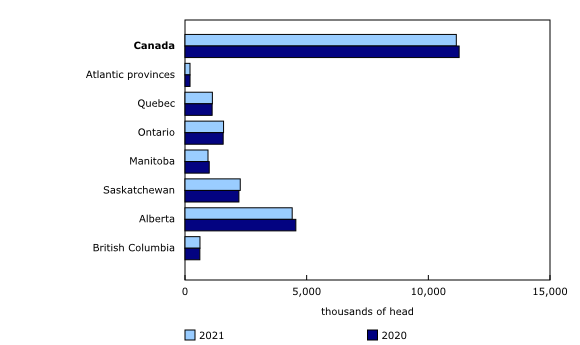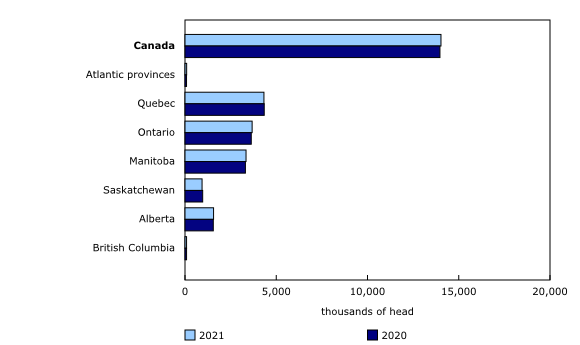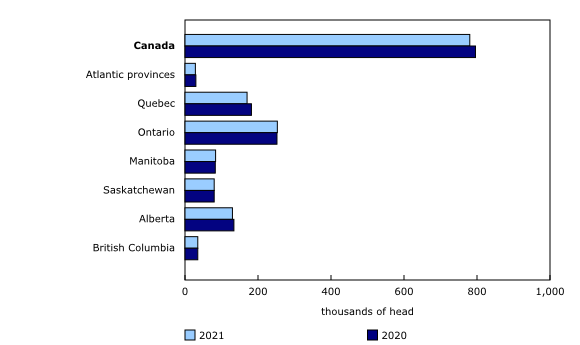Livestock estimates, January 1, 2021
Archived Content
Information identified as archived is provided for reference, research or recordkeeping purposes. It is not subject to the Government of Canada Web Standards and has not been altered or updated since it was archived. Please "contact us" to request a format other than those available.
Released: 2021-03-01
The COVID-19 pandemic continued to disrupt the activities of the livestock sector across Canada in the latter half of 2020. A resurgence of COVID-19 infections during the fall, temporary closures of processing facilities, and the introduction of enhanced public health measures maintained pressure on the sector.
Despite these challenges, from July to December 2020, processing plants adapted their operations to increase processing capacity and reduce existing backlogs. In fact, more cattle, hogs and lambs were slaughtered in the second half of 2020 compared with the same period in 2019.
Year over year, Canadian cattle and sheep inventories were down, while hog inventories were up, as of January 1, 2021.
Overall cattle ending inventories remained below January 1, 2020, levels, largely because of increased slaughter, coupled with lower births and imports. Canadian cattle inventories have generally declined year over year since 2005.
Meanwhile, hog inventories increased from the previous year as higher exports and slaughter were more than offset by piglet births. Despite trending upward during 2020, Canadian hog inventories have generally been stable since 2016.
Sheep inventories continued their year-over-year decline, which began in January 2017, as higher domestic demand for lamb was met with an increase in slaughter.
Supply and disposition
Cattle and calves
Canadian farmers held 11.2 million cattle on their farms on January 1, 2021, down 1.0% from the previous year, as the Canadian cattle herd continued to contract. Inventories were one-quarter (-25.3%) below the January 1 peak reached in 2005.
Inventories increased 0.9% to 2.9 million head in Eastern Canada, but decreased by 1.7% in Western Canada to 8.2 million head. Alberta had the largest cattle inventories among the provinces on January 1, contributing 39.5% to the Canadian total, followed by Saskatchewan (20.4%) and Ontario (14.2%).
As of January 1, 2021, 71,330 farms reported inventories of cattle and calves, down 1.8% from January 1, 2020. The number of cattle farms in Canada has been decreasing since 2004, largely attributable to business consolidations.
Cattle producers retained more breeding stock in the latter half of 2020 relative to the same period in 2019, as the number of beef heifers for breeding increased 4.1% to 545,400 head, while the number of bulls (+4.9% to 210,000 head) also rose from the previous year. This more than offset year-over-year decreases in the number of beef cows (-0.4% to 3.5 million head), dairy cows (-0.3% to 977,800 head) and dairy heifers for breeding (-2.4% to 427,700 head) on Canadian farms.
The inventory of calves on January 1, 2021, edged down 1.1% to 3.7 million head, in part because of a 3.5% year-over-year drop in births over the July-to-December period.
Canadian farmers held 1.4 million dairy cows and heifers on their farms. This total has remained fairly stable since January 1, 2018.
Producers held fewer feeder heifers (-4.5%) and steers (-4.2%) compared with January 1, 2020. Total slaughter of cattle and calves in the July-to-December period was up 0.6% year over year, as Canada's largest slaughter facilities restored their processing capacity to pre-pandemic levels, particularly throughout the summer months, which typically experience seasonal slowdowns.
International exports of cattle and calves for the July-to-December period decreased 2.0% year over year to 303,300 head. Export demand for Canadian cattle continued to be affected by COVID-19, as processing plants in the United States also faced backlogs of cattle for slaughter.
The July-to-December average price of Canadian feeder and slaughter cattle recovered slightly after sharp declines in the spring. However, prices generally remained lower in the second half of 2020 compared with the same period in 2019, as processors worked to clear backlogs resulting from temporary closures and slowdowns caused by COVID-19.
Hogs
Hog producers reported 14.0 million hogs on their farms, up 0.4% from January 1, 2020. The hog inventory remained 11.2% above the level from a decade earlier. The July-to-December pig crop, which represents the number of piglets remaining alive after weaning, was 14.9 million, the highest level since January 1, 2009.
Quebec, Ontario and Manitoba held the largest inventories among the provinces on January 1. The Eastern provinces are home to nearly 60% of Canada's hogs, with Quebec accounting for nearly one-third of Canadian hog inventories, at 4.3 million head. Quebec has held Canada's highest hog inventories since 1991.
As of January 1, 7,575 Canadian farms reported hogs, down 0.8% from the same date a year earlier. These farms reported 1.2 million sows and gilts, up 1.0%, while the number of boars remained virtually unchanged year over year.
Despite disruptions and backlogs in the processing sector created by COVID-19, Canadian hog slaughter maintained a fast pace. Total slaughter for the July-to-December period hit the highest levels since January 1, 2005, increasing 4.2% year over year to 11.5 million head. Chinese demand for pork meat remained strong in the latter half of 2020, as the country continued to recover from the effects of African swine fever.
Canada exported 2.8 million hogs in the second half of 2020, up 10.1% from the same period in 2019. The higher export demand for pork, as well as increased demand for weaner pigs in the United States, generally helped Canadian producer prices recover in late 2020 relative to the same period in 2019, following dips over the spring and summer months.
Sheep and lambs
Canadian producers had reduced their flocks of sheep and lambs on January 1, 2021, to the lowest inventory levels since January 1, 1999. The total number of sheep and lambs declined 2.0% year over year to 780,200 head.
Ontario and Quebec accounted for over half of the total Canadian sheep and lamb inventories on January 1.
The sheep breeding herd fell 1.0% year over year to 580,800 head, as reductions in the number of ewes (-2.1%) and rams (-1.3%) more than offset a 6.4% increase in replacement lambs.
International exports of sheep and lambs fell 58.7% year over year to 3,100 head, but remained slightly above the previous 10-year average for the July-to-December period. International imports of live animals totalled 8,400 head, the highest levels for the January 1 period since 2015.
The number of market lambs fell 4.8% from January 1, 2020, to 199,400 head. Lamb slaughter over the same period rose 2.6% to 336,200 head. Average prices for Canadian slaughter lambs were higher in the second half of 2020 compared with the same period in 2019, particularly in December 2020, as tighter supplies and higher domestic demand during the holidays helped support producer prices.
Note to readers
Livestock estimates are available for Canada and the provinces, as well as for the United States.
Products
Find more agriculture and food statistics.
Support the 2021 Census of Agriculture.
Contact information
For more information, or to enquire about the concepts, methods or data quality of this release, contact us (toll-free 1-800-263-1136; 514-283-8300; STATCAN.infostats-infostats.STATCAN@canada.ca) or Media Relations (613-951-4636; STATCAN.mediahotline-ligneinfomedias.STATCAN@canada.ca).
- Date modified:






